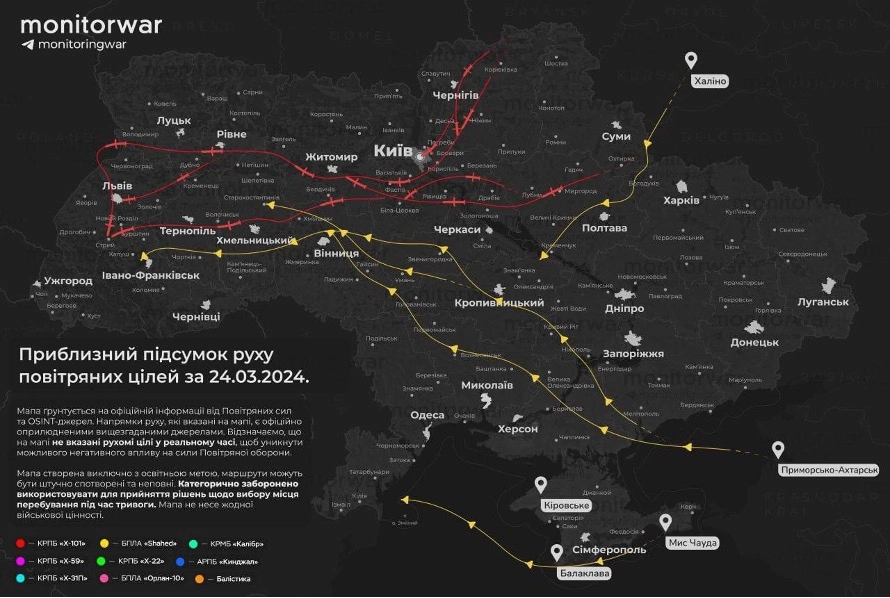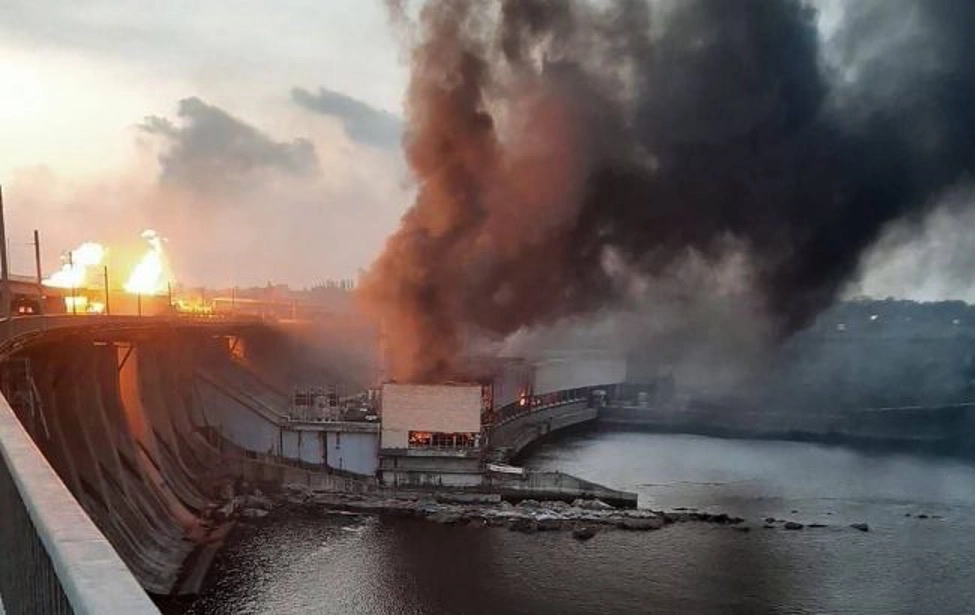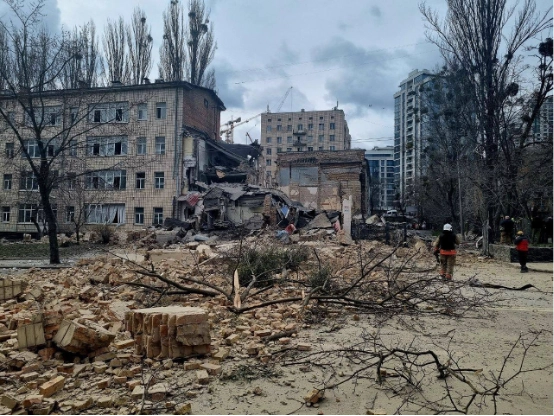Russian strike planners have re-started a campaign to bombard Ukraine’s power grid into oblivion and break civilian morale but, so far, things really aren’t going to plan.
On March 21 Moscow restarted nightly massed raids into Ukrainian air space targeting critical pieces of Ukraine’s power generation and delivery infrastructure and hoping to overwhelm its air defenses by presenting too many targets to take on at once.
JOIN US ON TELEGRAM
Follow our coverage of the war on the @Kyivpost_official.
The Kremlin ran a campaign with much the same objectives from Oct. 2022 - Jan. 2023, expending hundreds of guided cruise missiles, some worth as much as $5 million a shot. This was in a bid to plunge into fear and darkness during the coldest part of the year. In those days Kyiv was almost catastrophically short of air defense weapons to protect its brittle Soviet-era power grid.
The Kremlin eventually called off the attacks as its missile supplies began to get dangerously low, winter, which had been milder than normal was almost over, and because Ukrainian repair crews learned to fix damage faster than the Russian missiles could inflict it.
Fast-forward to March 22 this year, and the Russian military returned to the attack, but this time with far more sophisticated tactics.
In the past 72 hours, Russian strike planners are still trying to overwhelm Ukraine’s air defenses but, instead of simply hurling waves of cruise missiles straight at targets across the country they have been more subtle. They now launch combinations of cruise missiles, alongside cheap drones, extremely expensive ballistic missiles, and repurposed anti-aircraft missiles.

SBU Detains Top Military Psychiatrist Over $1 Million Wartime Corruption Scandal
They have programmed missiles to take indirect flight paths, in some cases fairly slow-flying cruise missiles, which are easier-to-shoot down, are used to detract air defenses by approaching form one direction while ballistic missiles, flying at three to five times the speed of sound and are therefore harder to hit, come at the same target from a different direction.
Typically, this type of strike mixes about 20 missiles of various types with around 30 Shahed kamikaze drones, the size of a refrigerator with a relatively small warhead of 50 kilograms which, if they successfully distract Ukrainian air defenses, leaves the way clear for missiles, some of which have warheads weighing close to half a ton.
Map showing multiple flight paths on March 24 shows how Shahed drones (yellow) are used to distract Ukrainian air defenses from missiles (red).
Ukraine’s air force estimated that over the weekend March 22 – 24, Russia launched over 150 separate aerial weapons with a total value of $677 million. Of those Ukraine’s air defenses managed to destroy 55 drones and 37 missiles.
The hardest-hit city was Ukraine’s second-largest city Kharkiv, where Russian missiles damaged three power sub-stations and two main electricity generation plants. That left more than a million people without power, aside from individually owned generators and storage batteries, and simultaneously shut down central heating and cut water supplies to tens of thousands of households.
Another strike targeted power grid infrastructure in southern Ukraine. Two missiles hit the central and western sections of generator station buildings at the DniproGes hydroelectric dam across the Dnipro River, while two more plowed into the dam itself. The generator stations went off-line, railroad lines running along the top of the dam were destroyed, power lines were knocked down and two gas fuel lines were cut.
Machine rooms burn at Ukraine’s DniproGes hydroelectric dam on March 22. Social media screen grab published by the RBK-Ukraina news platform.
In seconds, the regional power company, DniproGes, lost 20 percent of generation capacity.
Other weekend attacks targeted power generation infrastructure in the Vinnytsia and Donetsk regions, as well as the cities of Mykolaiv and Odesa. Some kamikaze drones attempted to hit port infrastructure along the Danube River, while large-scale mixed strikes hit underground natural gas storage sites and the Striy reservoirs in Ukraine’s western Lviv region.
Repair work started immediately across the country. Power companies in the Poltava, Sumy and Dnipropetrovsk regions adjacent to cities hit by Russian missiles, invoked mandatory blackouts to help reduce overall load on the national grid.
By Sunday heating had been restored to about 60 percent of city residents, and about 40 percent of consumers again had access to a working power grid in Kharkiv. Water supply and sanitation was restored in almost all city residents' homes, mayor Igor Terekhov said in a statement. According to him, three transformer substations and thermal power plants were destroyed.
By Monday morning in Kharkiv the metro was running again, albeit with a limited service. Ukrainian military blogger Anatol Herashchenko said: “Kharkiv power engineers have achieved the seemingly impossible - the city metro has started running again, trains are running on all lines.”
According to a Kharkiv city announcement, in order to limit load on the grid had only homes and businesses would be subject to mandatory blackouts lasting six hours out of every 24, on a rotating schedule. The statement said this would probably last until March 31.
Volodymyr Kurdritsky, head of Ukraine’s national electricity company Ukrenergo, cautiously predicted the power situation in Kharkiv might be returned fully to normal in one or two weeks, during a nationally televised news program on Sunday evening. Repair work is proceeding, he said.
"We know exactly what to do. We [Ukrainians] need to understand that restoring power supply in any region is a matter of time. In some places this can be done within a few hours, in others it can be one or two days. In others, as in Kharkiv, unfortunately, more time is needed. The main thing is that the situation is under control and these inconveniences that our consumers face, because of the attacks, are in any case temporary," he said.
In Zaporizhzhia region, inspectors checking the massive Soviet-era DniproGes hydroelectric station found the reinforced concrete dam had suffered only surface damage that did not affect structural integrity but, as a precaution, upstream water levels were being lowered to reduce pressure on the dam. Traffic was moving across the dam by Saturday, but two of four road lanes were closed. Repairs to generators and turbine assemblies could take months, reports said.
Power deliveries to customers in Krivi Rih were limited in some sections of the city on Sunday but had returned to normal service by Monday, a statement from the local power company DTEK said.
No power supply interruptions were reported following the Lviv-Striy strikes. Officials said 12 of the 19 missiles fired at area were shot down, and one fuel storage facility suffered limited damage.
Early on Monday morning, Russia continued the bombardment campaign with Shahed drone attacks against power grid targets along Ukraine’s Black Sea coast. According to Ukrainian army statements, a relatively modest 15 of the drones were launched and eight were shot down. There were no missiles.
By late morning electricity deliveries to homes had largely been restored, but Odesa city authorities had shut down metro bus and trolley services, and curtailed full power deliveries to heavy industry, to reduce the load on the city grid.
Shortly before midday on Monday a pair of Russian ballistic missiles were fired at Kyiv, which air defenses shot down; an event observed by a Kyiv Post reporter.
Seven people were injured and two hospitalized after one missile hit an uninhabited building and the second blasted a crater in dirt next to a village. A spokesman for Ukraine’s national security service (SBU) told Kyiv Post a facility operated by the agency was the Russian target.
Damage to uninhabited building in Kyiv following a strike by a Russian a hypersonic Tsirkon ballistic missile Mar. 25. Photo: Ukraine Ministry of Emergency Situations.
You can also highlight the text and press Ctrl + Enter













